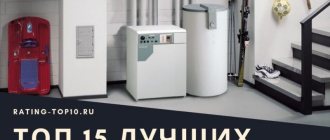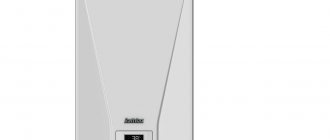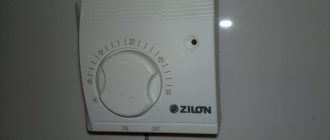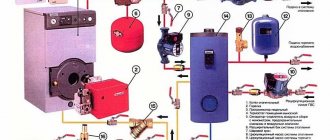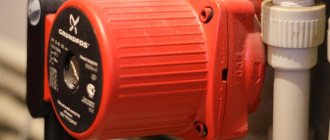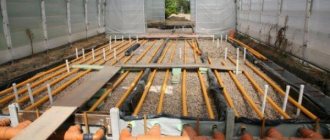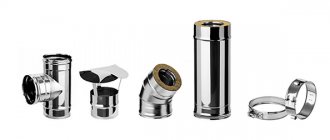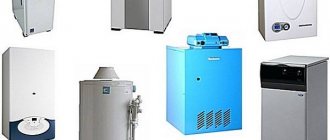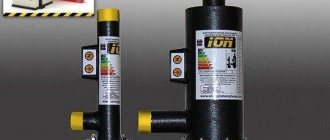Specifications
The main technical characteristics for such units are:
- There is a distinction between total pump power and useful power. The total shows how much the equipment consumed, and the useful one shows how much was spent on pumping liquid
Pressure or lift height ( H , m) is a value showing how much the pressure increases. It is measured in meters. To convert to pressure units there is a formula: 10m=1bar.
- Flow (Q, m3/h) – indicates the maximum amount of liquid that can be pumped per unit of time. This value depends on the pressure.
- Voltage (U, V) – shows the rated voltage in the network that is necessary for the operation of the unit. Basically it is either 220V or 380V.
- Useful power (N, kW) – distinguishes between the total power of the pump and the useful power. The total shows how much the equipment consumed, and the useful one shows how much was spent on pumping liquid.
- TO . P.D.( η) – a value showing the relationship between the total power and the useful one. The higher this value, the better.
- Shaft rotation frequency (ω, rpm) – shows the number of revolutions of the working shaft per unit time.
- Rated current (I, A) – normal current consumption by the pump. May increase or decrease as equipment operating conditions change.
- Type of pumped medium - depending on the application, it can be: process water, drinking water, waste or sewer liquid.
- Medium temperature (0C) – shows the permissible temperature range of the liquid that the equipment is capable of pumping.
Features and benefits of pumps
The main advantages of Grundfos pumps are:
- The optimum ratio of price and quality,
- high energy efficiency of equipment,
- a huge selection that can satisfy any need.
- quite long service life,
- good technical support.
When choosing pumping equipment, the following technical parameters must be taken into account:
- At Grundfos, the designers have thought through in advance almost all possible problems that may arise in a particular area of operation, therefore, when choosing equipment from this manufacturer, you get a unit that takes into account many years of experience
First you need to decide what type is needed. In total, there are three large groups: for wells, for heating, for drainage or sewerage. At Grundfos, designers have thought through in advance almost all possible problems that may arise in a particular area of operation. Therefore, when choosing equipment from this manufacturer, you get a unit that takes into account many years of experience.
- Before ordering equipment, you need to decide what type of voltage will be used: single-phase or three-phase. For household pumps, single-phase pumps are mainly used; in industry, three-phase pumps are more commonly used.
- The main characteristic when choosing a pump is the graph of pressure versus flow. This graph shows how much water the pump will pump depending on the required pressure. The higher the pressure that needs to be maintained, the less water the pump can pump. When choosing equipment, the required operating point must be under its curve. It is also necessary to provide a margin of 20% for the supply.
- Power is also an important parameter. It depends on the current and voltage. This parameter is taken into account when selecting pump protection, as well as when calculating the required cross-section of power supply cables. The higher the power, the greater the productivity.
- When choosing pumps, it is also necessary to take into account geometric parameters and connection dimensions. Before placing an order, you must make sure that the selected equipment is suitable both in weight and dimensions.
- Depending on the operating conditions, it is necessary to pay attention to the minimum and maximum permissible temperature of the pumped medium. There are cases when the wrong choice of range led to equipment failure.
- Also, when choosing from equivalent pumps, you need to choose the one with a higher efficiency rating. In the long term, such equipment will provide significant energy savings.
In order for the unit to work for a long time and without interruptions, it must be installed correctly. Installation of any equipment must be carried out strictly according to the attached installation instructions. Also, do not forget about installing automated control systems for pumps.
Such a system will protect your unit from power surges, from engine overheating, from the possibility of working without water, from water getting inside, etc., and will also allow you to control the process automatically, without human intervention.
Another condition for durability is proper operation. It is also stated in the instructions. It is important to understand that if a pump unit protection system is installed, then you need to be alert when it is triggered. It is best to carry out a full cycle of equipment inspection.
Grundfos UPS pump. Review
We will begin our journey into the world of Grundfos pumps with an introduction to the household series of circulation pumps.
Back in 1959, the company introduced its first circulation pump for heating with the same name Grundfos. All models in the series are successfully used in the forced heating system of private houses. A special place in the series is occupied by time-tested UPS pumps. Each Grundfos UPS pump is equipped with a three-speed switch, allowing it to be more accurately matched to the hydraulic parameters of the system. The pump is manufactured in two versions with different frequencies: 50 Hz for Russia and 60 Hz for European consumers. The series is used in both open and closed heating systems.
Structurally, UPS pumps are manufactured using “wet-rotor” technology; in a word, the hydraulic part of the pump and the engine form a single whole. In this design, the rotor is completely sealed. This solution eliminates the need for a mechanical seal; instead, only a pair of seals are used. In addition, the pump does not have an impeller for cooling the engine, and the pumped liquid protects it from overheating; it also acts as a lubricating element for the bearings.
The Grundfos UPS pump circulates coolant in heating and air conditioning systems. Special production of pumps made of bronze and even stainless steel solves the problem of using them in hot water supply.
The Grundfos UPS pump currently has 28 products. This diversity is explained by the need for more accurate pump selection in modern heating systems. Despite the abundance of names, all models are easy to remember; you just need to remember the markings.
Grundfos UPS pump marking:
Let's look at the circulation pump GrundfosUPS25–40 as an example:
- Up – designation of equipment such as a circulation pump;
- S – pump equipment with speed switch;
- 25 – pipe diameter, mm. (there are pumps of 25, 32, and 40 mm);
- 40 – the highest pressure indicator, dm (40 dm = 4 m) – at the third speed.
Additionally, you can remember that there are pumps with the index “F”, for example the Grundfos UPS 40-100 F pump, this index “F” indicates a flanged connection of the pump to the pipe.
In addition, there are pumps with an installation length of 130 mm, then the designation contains the following marking UPS 25-40 130. Pumps with a length of 130 mm are most often used in limited space, for example in wall-mounted boilers.
Equipment with a flange connection, due to the small size of the pump, is used in isolated cases on a 40 mm pipe. In general, standard pumps with an installation length of 180 mm and with connecting nuts for a pipe of 25 mm are used. – one and a half inch nuts G1 1/2″, for a 32 mm pipe. nuts two inches G2″.
It is worth noting that the manufacturer supplies UPS pumps with nuts, which largely frees the buyer from possible misunderstandings, such as purchasing nuts of the wrong size. Recently, additions have been made to the Grundfos pump housing - “noises” have appeared, which are convenient for holding the pump with a wrench.
Grundfos UPS pump with letter “A”
A special model is the Grundfos UPS pump with the letter “A”, which is essentially a hybrid of a circulation pump combined with an air separator. The model allows you to successfully separate the air contained in the water and remove it using an air vent.
The pump is installed in the direction of the water flow from bottom to top. Please note that the air vent itself is not included in the delivery package of the pumps and is sold as an auxiliary accessory. The air vent is installed by screwing in; for this purpose, the housing is equipped with an internal thread Rp 3/8“.
Let's consider how long submersible pumps for wells last
In order of increasing service life.
1) Screw and screw pumps for wells. These include such brands and models as: Caliber NTsPS, Unipump Eco Screw, Belamos 3sp 60/1.8, Whirlwind SN 90 and a lot of electric pumps of similar design. These models have a rubber screw as a working part, and not a polymer impeller like centrifugal pumps.
Screw pumps operate from 5 minutes to 1.5 years according to our statistics. On average 7 months - 1 year. However, there is still a possibility that a screw electric pump can last 5 years. It's just extremely small. The price of these well units ranges from 4 to 9 thousand approximately.
The following problems can occur with screw pumps (to watch the video, click on the image below):
Here is a video about the operation of a 4-inch screw pump:
2) Centrifugal pumps in the budget price segment. From 8 thousand for pumps for shallow wells to 30 thousand for pumps for wells over 100 - 150 meters 150 meters.
These are Chinese pumps Belamos, Aquatek SP, Gilex Vodomet Prof, Whirlwind SN, Unipump, etc., Ukrainian Aquarius BCPE.
Three-inch Chinese work for an average of 2.5 years. Aquarius can safely be given primacy; he often lives for more than 5 years and up to 10-12. Four-inch Chinese pumping equipment lasts longer, but Aquarius BCPE, in our practice, and in reviews from the forums, is the clear leader here.
From time to time, the problem of non-working Chinese pumps can be eliminated quickly and inexpensively, we talk about this in the video below:
4) Pumps of the middle price segment of the Italian brands Pedrollo, Aquario ASP. The service life of Pedrollo ranges from 5 to 15 years - a lot depends on the operating conditions. Often, when owners forget to monitor the pressure in the hydraulic tank, the pump begins to turn on and off frequently. So, under such conditions, Chinese submersible centrifugal electric pumps burn out, while Pedrollo (and Grundfos) simply damage the downhole underwater motor power cable, the motor itself remains intact.
With constant proper maintenance, the service life of such well pumps can be 6-8 years. And in some cases more.
4) Expensive pumps. The service life of Grundfos SQ submersible electric pumps can vary significantly. In our practice, in poor conditions (highly ferrous water, salt water, problems with electricity), pumps operate for 5-6 years. If the conditions are good, they can work for more than 10 years. Also, the statistics on Grundfos SQ pumps need to be adjusted, since for the last 5 years Grundfos pumps produced in Mexico have been supplied to Russia, and not Denmark, as was the case before. There are still some complaints about this brand and the need to diagnose problems after 1-3 years of operation, but in the vast majority of cases we can say that Grundfos SQ is the electric pump that you set and forget. One of the tested pumps.
There are, of course, cases when Grundfos work for 2-7 years:
Grundfos UPS pump, selection. Selection table.
If we want to choose the right Grundfos UPS circulation pump, first we need to determine such characteristics as pressure = H in
meters, and consumption = Q in cubic meters. Then you need to calculate how much heat will be needed to heat your area.
To do this, a boiler with power is initially selected based on the parameters of the house. The calculation is not easy, you will need the dimensions of the area, you will have to take into account the number of radiators in the system, take into account the insulation of the house, decide on the installation of windows, ceiling heights, and so on and so forth. We advise that it is better to leave the calculations to specialists and experienced installers.
As a result of the calculations, we will obtain the required values; using them, based on the graphs of the hydraulic curves, we select the pump. But for simplicity, you can use the table for selecting pumps depending on the area of the house. In addition, as we know, the Grundfos UPS pump has three speeds, with which we will adjust the pump to our system.
| Heated area (m2) | Productivity (m3/hour) | Brands Grundfos UPS |
| 80 – 240 | From 0.5 to 2.5 | UPS 25 – 40 |
| 100 – 265 | From 0.5 to 2.5 | UPS 32 – 40 |
| 140 – 270 | From 0.5 to 2.7 | UPS 25 – 60 |
| 165 – 310 | From 0.5 to 2.7 | UPS 32 – 60 |
As can be seen from the table above, the owner of a two-story house with an area of 100-265 m2 is recommended to use a Grundfos UPS 32/40 or UPS 32/60 heating pump if he has water-heated floors. The decision to consult with your heating system installers is welcome; they know your system more accurately and, based on experience, will suggest the best size of Grundfos pump. You can also select a UPS pump based on the known boiler power according to the table below:
In this matter, the rule does not work - the more powerful the better, since an oversized pump in terms of hydraulic parameters, firstly, consumes more electricity, which leads to low energy efficiency. Secondly, the pipeline system may make noise, causing significant discomfort to your household. In the video, the legendary Grundfos UPS 25-40 180 pump.
Well pump Grundfos
Devices from the Danish company Grundfos, despite the substantial price, are quite widespread among summer residents in the Moscow region. Let's see what models you can buy and their differences from each other:
- Grundfos SQ.
- Grundfos SQE.
- Grundfos SP.
The Grundfos SQ deep-well pump is the classic and most popular pump. The pump designation contains 2 numerical values, for example Grundfos SQ 2-70. The first number 2 indicates the nominal capacity (2 m3/hour), and the second number 70 is the nominal head (70 meters) at which a capacity of 2 m3/hour is ensured.
These pumps are protected against dry running, overloads, voltage surges, and also have a soft start. With a diameter of 3 inches (74 mm), Grundfos SQ is used in those wells where a classic 4-inch pump will not fit. As an example, we can give a well with 133 casing pipe and 110 or 117 mm plastic. Characteristics of Grundfos: Nominal pressure - 15-155 meters (depending on the model). Maximum pressure - up to 235 m. Maximum productivity - up to 7.5 m3/hour. Power - 700-1850 W. Weight - 4.7-6.7 kg. Diameter: 74 mm (3 inches).
The Grundfos SQE submersible centrifugal pump is the same SQ, but with a variable speed motor, which makes it possible, together with the SQE kit, to maintain stable pressure in the system. The SQE kit includes a pressure sensor with a pressure gauge and plug, an automation unit and a membrane tank. Otherwise, the characteristics of the Grundfos SQE pump are similar to the standard SQ.
Grundfos SP pump is a powerful multi-stage version of the SQ. It differs from the latter in its larger diameter (4 inches or 101 mm), three-phase design (there are several single-phase models) and impressive technical characteristics that allow it to be used in any domestic well.
The pump modification is indicated by two numerical values, for example Grundfos SP 3A-18, the first number 3 is the productivity in m3/hour, the second number 18 is the number of stages. Characteristics: Maximum pressure up to 540 meters (depending on model). Maximum productivity - up to 18.7 m3/hour. Power - 370-7500 W. Weight - 9-92 kg. Diameter: 101 mm (4 inches).
There is no doubt about the reliability of Grundfos pumps; these are premium products and the quality is at the highest level. The disadvantages include the high price; it differs significantly from all other well-known brands. This is what makes us look for alternatives.
But, despite the high reliability of the design itself, Grundfos SQ had one unpleasant drawback - it does not hold the check valve. This problem arose after the transfer of pump production from Denmark to Mexico. Almost every second Mexican model had this problem. To correct the situation, you need to buy a check valve separately. This is exactly what we began to do several years ago. Having gotten caught in this several times in a row and having lost a lot of time disassembling and assembling the water supply system, we began installing a check valve on all models without exception. This problem may have been resolved today. If you have time to disassemble and reassemble the water supply system, then you can check. Otherwise, buy a check valve, it costs about 1000 rubles.
Grundfos pump life
The potential service life of Grundfos pumps is more than 15 years. Everything is done there at a really high level and you don’t have to worry about it. But you should worry about the scheduled maintenance of the pressure automatics. After all, after a while it may become upset and the pump will turn on more often than it should. This leads to excessive loads and premature wear. For this reason, even really high-quality devices (like Grundfos) fail ahead of schedule. Drillers recommend periodic maintenance of the automation to keep the system in working order. It is with this approach that the service life of Grundfos pumps can exceed 15 years.
Types of devices for heating systems
Grundfos pumps designed to operate as circulation pumps are divided into two main groups , the difference of which lies in the operating conditions of the drive motor rotor.
If only the pump impeller comes into contact with the pumped liquid, then this design is called “dry rotor”.
If the transported liquid contains both the impeller and the motor rotor, it is a pump with wet rotor characteristics.
Both types of construction have their own characteristics and areas of application.
Dry
The dry rotor is good high efficiency and high power. Pumps of this type are also little sensitive to the quality of the coolant and can easily tolerate contamination from suspended matter and fine abrasives. Operates at temperatures significantly higher than the permissible operating values of glandless rotor pumps.
Photo 1. Disassembled Grundfos circulation pump for a heating system, equipped with a dry rotor.
The disadvantages are a shorter service life, comparatively high cost, slightly larger size, the need for regular maintenance (lubrication), and high noise. For this reason, models with a dry rotor are best installed in a separate room. But at the same time, they are able to “pump up” large cottages or even apartment buildings.
Wet
The wet rotor is more compact, almost silent, and extremely durable when installed correctly. Does not require maintenance during operation, but is less productive, with a relatively low efficiency - no more than 50%.
With overall low power consumption (on average 6–100 W depending on power, mode and load), this characteristic is not decisive.
This type of pumping equipment is extremely sensitive to the quality of the pumped liquid, since it is both a lubricant and antifreeze for the rotor. Therefore, such devices cannot operate at temperatures above 115 degrees and require the installation of a mesh dirt filter in front of the pump.
Photo 2. Grundfos compact circulation pump with a wet rotor, sensitive to the quality of the pumped liquid.
Wet-type devices are widely used in individual heating and water supply systems as additional circulation pumps for the make-up line.
Types of Grundfos pumps
Circulation pumps of this brand differ from each other in characteristics and capabilities. Their classification is determined by several criteria. For example, the equipment can be single or paired. Most single units have only one rotor, the power of which is no more than 4 atmospheres. Such models are used in private housing construction. In contrast, paired devices are more powerful and productive equipment. But it also costs much more than single-type units.
In addition, the pumps differ in the way their rotor operates. It can be wet or dry. In devices with a wet rotor, the motor is located directly in the coolant and does not have a protective capsule. As a rule, these are primitive motors that consume minimal electricity and do not require lubrication. Their power does not exceed 4 atmospheres. This indicator ensures the movement of about 3 m3 of coolant per hour. This is enough for a country house.
Grundfos circulation pumps with a dry rotor have much higher power. Their engine is located in a sealed chamber and does not come into contact with the coolant. But these units have their drawbacks: they consume a lot of electricity and make a lot of noise. Therefore, they are not installed in country houses (in private housing construction there is no need for them also because such equipment is intended for pumping large volumes of coolant).
Also, these devices can have a different number of speeds. In single-speed devices, the rotation speed cannot be changed. As a rule, these are low-power models intended for installation in a private home. Multi-speed units can be adjusted to the desired operating mode. They have high power and cost more.
Selection options
If the Grundfos pump is considered as a supply pump (to replenish coolant losses and fill the system), then its main parameter is considered to be performance. Usually it is taken at the rate of 0.5% of the volume of the entire system.
But if the water device will work as a full-fledged circulation pump, then the choice should be stricter.
Power
This parameter shows how much volume the device pumps per unit of time. The choice depends on the heating power. It is better to take a pump with a small power reserve (but without fanaticism - a 10% capacity is enough), since at modes close to the maximum, the noise level may be exceeded. As a rule, the factory settings correspond to the lowest noise level.
Pressure
The pressure depends on the resistance of the system to dynamic pressure and the number of floors of the heated room. The more turns and control valves, the higher the performance should be.
The maximum pressure depends on the characteristics of the system. Static pressure in open systems is determined by the height of the expansion tank, in closed systems - by the pressure membrane.
Speed and noise
In addition to these parameters, you can pay attention to the additional options of the latest models of the concern.
For example, a pump with a three-position speed switch allows you to adapt the operation to the needs of the system and save on energy consumption (when compared with single-speed models).
But modern developments with electronic regulators are able to adapt so clearly to the conditions and needs of the heating system that they reduce energy consumption by 2–5 times. Not to mention reducing noise.
You need to know the following about noise: models with a dry rotor are noticeably noisier. Pumps with a wet rotor are practically inaudible during operation. But if their power exceeds the needs of the system or they work at the limit, the noise increases. Noise also
Reference! The latest Grundfos models are an excellent alternative to outdated pumps from other brands - they consume less energy and are noticeably quieter.
How to choose a pump
In order to select a pump you need to know the answers to the following questions:
- How much liquid needs to be pumped per unit of time (flow rate) Can be measured in m³/h, l/min, l/sec, gpm... 1m³/h ≈ 16.67 l/min ≈ 0.28 l/sec ≈ 3.67gpm
- What pressure should the pump develop at the specified flow rate (pressure) Can be measured in m, kgf/cm², bar, psi... 10m = 1kgf/cm² ≈ 0.98bar ≈ 14.22psi
- What will the pump pump (purpose)
- Where the pump will be installed (design) More information about the purpose and design of pumps can be found in the articles describing the pump sections.
How to choose a Grundfos pump?
Equipment that will provide water supply to a private house, cottage or summer cottage must meet the following characteristics:
- installation method: surface pumps are easier to repair, while submersible pumps make less noise;
- the maximum pressure determines to what height the unit can deliver water from a well or other source;
- energy efficiency - the amount of electricity consumed when connected to the network;
- water temperature: some pumps allow the use of only cold water, while others are compatible with liquids with temperatures up to 100 degrees;
- productivity, or throughput, is an indicator indicating how much water the pump is capable of producing per unit of time;
- the material of the case determines the lightness, reliability and durability of the system;
- dimensions and weight determine the simplicity and ease of installation and maintainability of the unit;
- protective functions, for example, protection against overheating or dry running, provide a high level of operational safety of the device, and also increase the autonomy of the pump;
- complete set - the presence of the necessary cords, tools and fasteners for the fastest and easiest installation.
What is needed for selection?
The main characteristics required when choosing any water pump include:
- operating flow , that is, the amount of water pumped per unit of time;
- the amount of pressure required , which is the pressure at the outlet of the pump.
The operating point is determined from the flow and pressure values in the program. To do this, select the most suitable operating schedule for the desired family of pumps, which has a point with the closest parameters.
What parameters may be needed?
When selecting pumps for water supply, sewerage and other needs, it is necessary to take into account the specific operating features of units for various purposes.
Pump type Parameters
| Heating circulation pump | Heating system parameters - coolant temperature, total heat load, pipeline diameters |
| Downhole units | The size of the well and its flow rate (the amount of water that can be pumped out per unit of time) |
| Submersible and drainage pumps | Presence and nature of solid particles. This determines the need to use cutting mechanisms |
| Booster pumps | Pressure to pump |
| Fire station pumps | Type of fire extinguishing system (sprinkler, deluge), pressure in the system, total flow rate of sprinklers |
Types of Grundfos water pumps
Grundfos heating circulation pumps are available in several basic modifications. Models can be divided into two groups:
- Circulation pump for hot water.
- Equipment designed to be connected to a heating system.
Some models are universal and can simultaneously connect to radiator heating systems, heated floors and hot water supply.
Installing a Grundfos circulation pump of the required modification will completely solve the issue of automation of the heating and hot water supply system.
The scope of application of Grundfos pumping equipment is not limited solely to domestic needs. The main directions are:
- Creation of a heating system for an apartment building.
- Installation for a private home, regardless of the type of water heating equipment and the type of fuel used.
- Installation in cooling and air conditioning systems.
- Connection to heated floors, radiators and heated towel rails.
- Industrial building.
What determines the cost of a pump?
The choice of any equipment represents a compromise between its cost and functionality, so the consumer should take into account factors that influence the rise in cost of the order. Among them are:
- The nature of the working environment For example, its increased aggressiveness requires the use of particularly resistant materials; contamination places certain demands on the working parts of pumps
- The value of the maximum operating pressure The material of the housing parts of high-pressure pumps must have increased strength, requires a different manufacturing technology and an increase in metal consumption
- Operating temperature Operation at elevated temperatures requires the use of appropriate materials, this also applies to the design of sliding seals
- Equipping pumping units with a frequency-controlled drive. A frequency converter allows you to save up to 30-40% of electricity during periods of off-peak water consumption, but at the same time increases the final cost of the pump.
- Pump material , which can be brass, various grades of cast iron or stainless steel, significantly affects the total cost of the order.
Rules for installing Grundfos water equipment
First you need to decide on the installation location. In theory, the device is placed in any break in the main line. But in practice it is better to do this on the return pipe - as close to the boiler as possible. Between the boiler and the pressure (expansion) tank. This arrangement will reduce the thermal load on the pump structure and its working blades.
Important! When installed on the outlet line, the coolant may boil on the impeller blades, which will ultimately lead to rapid wear.
The best option would be to choose a horizontal pipe section. Although it is possible to install the pump on a vertical section.
True, it is important here that the flow in this place goes from bottom to top, and not vice versa - in order to avoid airing.
When installing the pump, you need to make sure that its rotor is horizontal - when tilted, air may accumulate and quickly wear out due to insufficient lubrication (in pumps with a wet rotor).
pump terminal box is placed on top to prevent water from entering if the line loses its seal.
Attention! It is important to ensure that the equipment is not installed close to a heating radiator, which may cause the internal thermostat to malfunction .
The pump is connected through a bypass - bypass branch. At a selected point in the line, a gap is made into which a ball valve is placed for automatic adjustment, or a ball valve is placed for manual mode switching, which is throttled with a bypass jumper.
with two shut-off ball valves at the inlet and outlet (to be removed if necessary). A dirt filter and a valve (when there is no built-in one) must be placed in front of it to remove air.
Guided by the instructions for the maximum power consumption (indicated on the case and in the technical data sheet), select an automatic fuse for the power supply. It is also possible to connect the device through an automation system: thermostat or timer.
Pump replacement
Replacing a pump that has exhausted its service life sometimes causes problems, since the same pump may well have been discontinued during its operation, and the replacement recommended by the manufacturer may differ significantly in connection dimensions. And even if there are no such problems, in any case it is advisable to consider other replacement options. The development of pumping equipment does not stand still, new manufacturers are entering the market, competition is forcing manufacturers to optimize pumping equipment. As a result, to replace a pump that has exhausted its service life, another one may appear, more suitable for specific technical conditions and significantly cheaper.
As an example of the feasibility of such a replacement, I usually cite the possibility of replacing flanged circulation pumps with a wet rotor with the same characteristics, only with a dry rotor. The price gain can be more than double. At the same time, pumps with a dry rotor have advantages in the form of higher efficiency and maintainability. The disadvantages of such a replacement include the need to rework the pipeline, because in most cases the connecting dimensions will be different and the need to install vibration-damping inserts if the heating system is implemented with steel pipes and the distance to living quarters does not compensate for the vibration that occurs during operation. However, the cost of solving these problems often does not compare to the price difference.
Another typical option for replacing an old pump with a new one is to replace a flanged cantilever pump on a slab with a flanged close-coupled pump. Old Soviet-made cantilever pumps did not have such high efficiency as modern ones; in addition, they were designed and installed with a significant margin, and correct replacement of such a pump will lead to significant energy savings.
Modern well pumps are more flow optimized than older ones. And where pumps with a diameter of 6-8 inches were previously used, it is now quite possible to use pumps with a diameter of 4-6 inches, which are cheaper.
A reasonable approach to replacing a pump that has reached the end of its service life, in most cases, leads to cost savings, reduced operating costs and an increase in the time until the next replacement.
JP (Grundfos)
VA 50, VA 60 (DAB) CA (Calpeda) DG Blue, DG BluePRO (Zenit) TCR (Lowara) EURO, EUROINOX, EUROCOM (DAB)
Pump energy efficiency
Well-known European manufacturers of pumping equipment have made great strides in optimizing energy consumption, introducing several wet rotor models to the market. This was achieved through the use of modern DC electric motors controlled by a controller. Such models belong to class “A” equipment, which is considered the most effective in terms of minimizing energy losses - their consumption does not exceed 0.09-1.3 kW).
Grundfos specialists have developed a whole series of energy-saving pumps under the names ALPHA2 and MAGNA3. The former are distinguished by simple functionality and are intended for use in heating and hot water systems of private houses. Models of the second type have the AUTOAdapt function, which allows you to automatically set the optimal power consumption mode. Their capabilities meet modern requirements for the efficiency and performance of equipment in this class. They are designed for use in heating systems of private homes and industrial enterprises.
Grundfos circulation pumps
The use of circulation pumps allows you to get rid of possible rupture of pipes when the coolant freezes due to weakened circulation.
Grundfos is one of the most famous brands in Russia and around the world. It is the largest manufacturer of pumping equipment. Its circulation pumps are used not only in heating systems, but also in boilers, being an element of the built-in piping. Open any gas boiler from a well-known brand - with a 95% chance there will be a Grundfos pump there. Go to any store and look at the display case with pumping equipment - 95% of your eyes will be focused on Grundfos products, and only a small part of the devices will be manufactured by other brands.
By choosing a Grundfos heating circulation pump, you are choosing high-quality pumping equipment. If devices from other brands begin to break down or make noise 2-3 years after the start of operation, then equipment from Grundfos remains afloat for up to 10 years or even more, without experiencing breakdowns. Let's look at the main advantages and features of pumping equipment from this brand:
- High reliability of electric motors is the key to long service life of equipment;
- The minimum noise level is a very important indicator, since even a quiet hum or vibration of the rotor can be amplified by the pipes and cause discomfort to household members;
- Ability to work in heating systems of any type – including as part of “warm floors”;
- The ability to fine-tune the equipment to select the appropriate operating mode - economical, summer, etc.;
- Low power consumption – allows you to save on electricity;
- Rotor shafts and bearings made of ceramics – maximum endurance even under heavy loads;
- Grundfos service throughout the country - if the circulation pump breaks down, you can always count on qualified repairs.
In other words, the Grundfos heating circulation pump is the most reliable pumping equipment that can be purchased in a store.
Operating modes
A modern recirculation pump for heating is a multifunctional device. Various samples of this equipment are capable of operating in the modes indicated in the passport, including “fixed speed”. All of them are equipped with a synchronous motor, the operation of which is controlled by a built-in processor. During operation of the unit, the control unit records the following main parameters:
- current strength;
- rotor speed;
- temperature in the working area and others.
Its presence allows you to adapt to a specific heating network with optimal energy consumption.
We analyze the features of the products
Like any other equipment, grundfos well pumps have their pros and cons in design and operation.
The advantages of the equipment produced are:
- Possibility of operation in a wide temperature range. Grundfos deep well pumps are capable of operating in a temperature range from -25 to +140 degrees Celsius.
- Most models of equipment produced by the company have remote control.
- All models produced by the company are equipped with automatic workflow control units. Pump operation control units have computer chips that are capable of making adjustments to the operation of the equipment depending on operating conditions in automatic mode.
- The pumps are characterized by virtually no noise during operation.
- Power settings allow you to reduce or increase it depending on the operating conditions of the equipment. The power setting usually has three levels.
- Most models of manufactured equipment do not require special training before use.
- All equipment components are treated with a special powder that reliably protects them from corrosion.
The only disadvantage of the equipment produced by the company is the ability to operate pumping equipment in one of the positions: either horizontal or vertical, which is not always convenient and feasible. This feature of the equipment requires its careful selection in accordance with operating conditions. Although, for the sake of fairness, it should be said that the company produces equipment capable of operating both horizontally and vertically.
Watch a video about borehole models:
Types of grundfos pumps, their technical characteristics and cost on the market The equipment is produced in several types, each of which includes a number of models with differing technical characteristics. For domestic use, household submersible pumps are produced, which belong to the SQ and SQE series. SQ series pumps are intended for pumping liquids that contain various impurities and particles with a contamination density of no more than 50 grams per cubic meter.
With a higher degree of contamination, it can cause a significant reduction in the operating life of pumping equipment. The equipment in this series is made of stainless steel and has high efficiency. Models in this series can be installed in wells up to 3 inches in diameter. sq deep-well pumps have built-in water level sensors that turn off the equipment automatically when the minimum level is reached.
Watch a video about the SQE series:
Models of the SQE series have characteristics similar to models belonging to the SQ series. Models of these series are used to supply water to small water supply networks in private houses and cottages, as well as to organize irrigation of a personal plot. For industrial use, the company produces lines of models belonging to the SP and SPA series. These series of pumping equipment are presented by the company in a huge assortment. They are used to meet industrial water needs.
Industrial and household
The industrial models of these series are largely similar to each other. They have a long service life. Used when installed in mines, wells or technological tanks, they ensure an uninterrupted supply of water in large volumes.
Domestic Grundfos well pumps have a price that largely depends on the equipment included. The cost of household equipment varies, as a rule, from 20,000 to 30,000 rubles, depending on the model and configuration.
Industrial pumps for Grundfos wells have a price, as a rule, several times higher than the price of equipment for household use. The grundfos borehole pump can be purchased in specialized stores, as well as in company stores. In addition, a plant for the production of equipment developed was opened on the territory of the Russian Federation and is located in the Moscow region.
Consumer Reviews
As a rule, with the correct choice of equipment and its proper operation, product reviews are positive. If the equipment is chosen correctly, it can be used for a long period of time without any problems.
“We spent a long time choosing the appropriate option, the depth of the well was 36 meters, and based on the recommendations we settled on the Aquarius model, which has been in operation for 5 years. No complaints or comments. We recommend it to everyone!” Ilya, Ulyanovsk.
“At this moment I am using a “Foreman” model pump in the well, that is, for now I will pump it using the vibration version. A very good option! No miscalculations. And as soon as clean water appears, I will install a centrifugal pump of the Vodomet model. I heard about his good qualities.” Kirill, Tver.
How to extend the operating time
Pumps, as a rule, do not require special care. Their operation requires strict adherence to the operating requirements set out in the technical documentation supplied with the pumping equipment.
The design of the pumps is designed in such a way that during normal operation, lubrication of all required structural elements is carried out automatically with water pumped by the equipment.
When choosing a pump for a well, it would be optimal to purchase Grundfos equipment based on many criteria. It is worth noting that, according to the majority of people who have experience using such equipment, Grundfos equipment is the best choice in the price-quality category, and if we add here the possibility of long-term operation without special costs, both physical and material, then we can say that the products are the best choice.
Related posts:
- How good is a deep well pump?
- We choose wisely the fecal pump for the dacha
- We clean the well with a drainage pump
- Criteria for choosing a submersible pump for dirty water
- Choosing reliable sewage pumps
Do-it-yourself pump disassembly
If repairs are necessary, the equipment must be taken to a service center if the device is under warranty.
Any user who has thoroughly studied the design can disassemble a purchased sample of pumping equipment if desired. The need for this often arises when it is necessary to repair or overhaul it with the replacement of worn parts. After complete disassembly, the main working components of the mechanism are inspected and then checked for wear.
The main attention is paid to examining the condition of the “wet” rotor. It should be removed and replaced with a new part in the presence of a repair specialist who can supervise this difficult operation.
Rating of popular models
Most often, this model is counterfeited by scammers, since it sells better.
The pump rating is based on a comparison of the technical indicators and operational capabilities of three models. In first place is the Grundfos UPS 25-60 (N) 180 product, which is a circulation unit with a cast iron body (this option is used only for heating). Its modification for hot water supply has a stainless steel body. All samples are equipped with a single-phase asynchronous motor, a speed switch and a special sleeve separating the rotor and stator.
The advantages include:
- permissibility of use in any type of circuits (closed and open);
- wear resistance and efficiency (consumption no more than 60 W);
- low noise level (up to 43 dB);
- compactness, low weight and overheating protection;
- ease of installation and maintenance;
- long service life.
The disadvantages of these products are the obsolescence of individual models and their high cost.
The second position is occupied by a Grundfos ALPHA2 25-40 180 , equipped with a built-in permanent magnet electric motor. The power consumed by this device from the network is 0.022 kW, and the productivity is 2.4 m3/hour. At an operating temperature of the coolant from +2 to +110 °C, the pressure created in the circuits is 4.0 meters.
The Alpha model is made of cast iron and has an increased service life
This product has a pure cast iron body and is equipped with an efficient wet rotor motor and ALPHA plug. Vertical or horizontal installation of the unit is allowed, which, after startup, is controlled via built-in electronics. All information about the possible operating modes of the device, its energy consumption and typical breakdowns is displayed on the display located on the front panel.
The positive aspects of this model include:
- Low power consumption (only 22 watts).
- Small dimensions (10x15x18 cm) and light weight (2.1 kg).
- Low noise level during operation (no more than 43 dB).
- Protection from corrosion (the body is made of stainless steel).
- The presence of the AUTOADAPT function, as well as the ability to select night or summer mode.
- Low level of heat loss (the housing is insulated with a protective casing).
- Possibility of setting fixed operating modes.
- Long-term warranty (up to 5 years).
The disadvantages of this product are the frequent malfunctions of the electronics, as well as the lack of special protection against dry running.
The third place is confidently occupied by the Grundfos UPA 15-90 (N) - a modern monoblock type unit, which has characteristics slightly worse than the previous model.
Grundfos pumps for increasing pressure in the cold water system
Grundfos UPA 15-90 (N) – surface pump for boosting pressure
The Grundfos UPA 15-90 (N) pump is a monoblock type booster unit: there is a sleeve between the rotor and stator; There is no shaft seal. It is completed with a cast iron (stainless steel) housing, a single-phase motor and a terminal box.
It works after the tap is opened and the flow switch is activated at a minimum inlet pressure of 0.2 bar. Controlled manually or automatically. Characteristics: head 8.0 m, flow 1.5 m3/h, water temperature from +2 to +60 °C.
READ ALSO
12 Best Sump Pumps
Pros:
- efficiency (118 W), noiselessness (up to 35 dB), lightness (2.7 kg) and compactness (L=16 cm);
- the ability to choose between manual and automatic modes;
- corrosion resistance and reliability: materials of manufacture – cast iron, stainless steel, aluminum oxide, composite and graphite;
- protection against idle operation (in automatic mode) and protection against overheating (pumped water);
- ease of installation, ease of use, low maintenance;
- long service life (10 years) and reasonable price (5.0-6.6 thousand rubles).
Minuses:
- only one speed;
- the Grundfos UPA 15-90N version is relatively expensive: price - 11.0-12.6 thousand rubles.
Grundfos MQ 3-45 – surface self-priming pump for increasing pressure
The Grundfos MQ 3-45 pumping station is an automatic pumping station with a suction depth of 8 m and a lifting height of 46 m. Consuming 1.0 kW of electricity, it supplies 4.1 m3/h of water with temperatures up to +35 °C. Equipped with an electric motor, ejector, check valve and hydraulic accumulator.
Operates using a flow sensor and pressure switch at minimum values: Q = 1.2 l/s, P = 2 bar. Current information is displayed on a panel with fault indicators and 1 button.
Pros:
- low noise (55 dB), compactness (22x57x32 cm), lightness (13.0 kg);
- resistance to wear and corrosion: the body and working elements are made of chromium-nickel steel;
- increased working life: thanks to the hydraulic accumulator, on/off cycles are repeated with less frequency;
- there is no reverse flow of water: the station is equipped with a non-return valve;
- protection against dry running, overheating, overload and jamming;
- price corresponding to the quality (19.2÷24.2 thousand rubles) and a 10-year service life.
Minuses:
- integrated hydraulic accumulator – small-sized;
- expensive repairs: usually necessary if installation and operation are not competent.
READ ALSO
12 Best Pool Pumps
